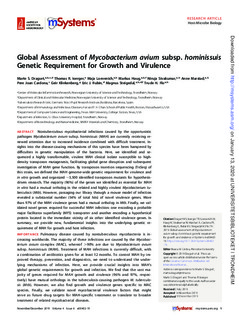| dc.contributor.author | Dragset, Marte Singsås | |
| dc.contributor.author | Ioerger, Thomas R. | |
| dc.contributor.author | Loevenich, Maja | |
| dc.contributor.author | Haug, Markus | |
| dc.contributor.author | Sivakumar, Niruja | |
| dc.contributor.author | Marstad, Anne | |
| dc.contributor.author | Cardona, Pere-Joan | |
| dc.contributor.author | Klinkenberg, Geir | |
| dc.contributor.author | Rubin, Eric J. | |
| dc.contributor.author | Steigedal, Magnus | |
| dc.contributor.author | Flo, Trude Helen | |
| dc.date.accessioned | 2020-01-13T09:36:44Z | |
| dc.date.available | 2020-01-13T09:36:44Z | |
| dc.date.created | 2020-01-08T10:56:54Z | |
| dc.date.issued | 2019 | |
| dc.identifier.issn | 2379-5077 | |
| dc.identifier.uri | http://hdl.handle.net/11250/2635871 | |
| dc.description.abstract | Nontuberculous mycobacterial infections caused by the opportunistic pathogen Mycobacterium avium subsp. hominissuis (MAH) are currently receiving renewed attention due to increased incidence combined with difficult treatment. Insights into the disease-causing mechanisms of this species have been hampered by difficulties in genetic manipulation of the bacteria. Here, we identified and sequenced a highly transformable, virulent MAH clinical isolate susceptible to high-density transposon mutagenesis, facilitating global gene disruption and subsequent investigation of MAH gene function. By transposon insertion sequencing (TnSeq) of this strain, we defined the MAH genome-wide genetic requirement for virulence and in vitro growth and organized ∼3,500 identified transposon mutants for hypothesis-driven research. The majority (96%) of the genes we identified as essential for MAH in vitro had a mutual ortholog in the related and highly virulent Mycobacterium tuberculosis (Mtb). However, passaging our library through a mouse model of infection revealed a substantial number (54% of total hits) of novel virulence genes. More than 97% of the MAH virulence genes had a mutual ortholog in Mtb. Finally, we validated novel genes required for successful MAH infection: one encoding a probable major facilitator superfamily (MFS) transporter and another encoding a hypothetical protein located in the immediate vicinity of six other identified virulence genes. In summary, we provide new, fundamental insights into the underlying genetic requirement of MAH for growth and host infection. | nb_NO |
| dc.language.iso | eng | nb_NO |
| dc.publisher | American Society for Microbiology | nb_NO |
| dc.rights | Navngivelse 4.0 Internasjonal | * |
| dc.rights.uri | http://creativecommons.org/licenses/by/4.0/deed.no | * |
| dc.title | Global Assessment of Mycobacterium avium subsp. hominissuis Genetic Requirement for Growth and Virulence | nb_NO |
| dc.type | Journal article | nb_NO |
| dc.type | Peer reviewed | nb_NO |
| dc.description.version | publishedVersion | nb_NO |
| dc.source.journal | mSystems | nb_NO |
| dc.identifier.doi | 10.1128/mSystems.00402-19 | |
| dc.identifier.cristin | 1768361 | |
| dc.relation.project | Norges forskningsråd: 223255/F50 | nb_NO |
| dc.relation.project | Norges forskningsråd: 249901 | nb_NO |
| dc.description.localcode | Copyright © 2019 Dragset et al. This is an open-access article distributed under the terms of the Creative Commons Attribution 4.0 International license. | nb_NO |
| cristin.unitcode | 194,65,15,0 | |
| cristin.unitcode | 194,65,1,0 | |
| cristin.unitname | Institutt for klinisk og molekylær medisin | |
| cristin.unitname | MH fakultetsadministrasjon | |
| cristin.ispublished | true | |
| cristin.fulltext | postprint | |
| cristin.qualitycode | 1 | |

